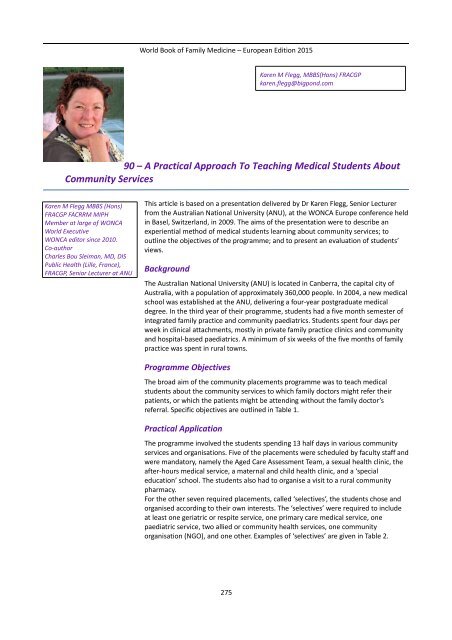Family Medicine
World Book 2015
World Book 2015
Create successful ePaper yourself
Turn your PDF publications into a flip-book with our unique Google optimized e-Paper software.
World Book of <strong>Family</strong> <strong>Medicine</strong> – European Edition 2015<br />
Karen M Flegg, MBBS(Hons) FRACGP<br />
karen.flegg@bigpond.com<br />
90 – A Practical Approach To Teaching Medical Students About<br />
Community Services<br />
Karen M Flegg MBBS (Hons)<br />
FRACGP FACRRM MIPH<br />
Member at large of WONCA<br />
World Executive<br />
WONCA editor since 2010.<br />
Co-author<br />
Charles Bou Sleiman, MD, DIS<br />
Public Health (Lille, France),<br />
FRACGP, Senior Lecturer at ANU<br />
This article is based on a presentation delivered by Dr Karen Flegg, Senior Lecturer<br />
from the Australian National University (ANU), at the WONCA Europe conference held<br />
in Basel, Switzerland, in 2009. The aims of the presentation were to describe an<br />
experiential method of medical students learning about community services; to<br />
outline the objectives of the programme; and to present an evaluation of students’<br />
views.<br />
Background<br />
The Australian National University (ANU) is located in Canberra, the capital city of<br />
Australia, with a population of approximately 360,000 people. In 2004, a new medical<br />
school was established at the ANU, delivering a four-year postgraduate medical<br />
degree. In the third year of their programme, students had a five month semester of<br />
integrated family practice and community paediatrics. Students spent four days per<br />
week in clinical attachments, mostly in private family practice clinics and community<br />
and hospital-based paediatrics. A minimum of six weeks of the five months of family<br />
practice was spent in rural towns.<br />
Programme Objectives<br />
The broad aim of the community placements programme was to teach medical<br />
students about the community services to which family doctors might refer their<br />
patients, or which the patients might be attending without the family doctor’s<br />
referral. Specific objectives are outlined in Table 1.<br />
Practical Application<br />
The programme involved the students spending 13 half days in various community<br />
services and organisations. Five of the placements were scheduled by faculty staff and<br />
were mandatory, namely the Aged Care Assessment Team, a sexual health clinic, the<br />
after-hours medical service, a maternal and child health clinic, and a ‘special<br />
education’ school. The students also had to organise a visit to a rural community<br />
pharmacy.<br />
For the other seven required placements, called ‘selectives’, the students chose and<br />
organised according to their own interests. The ‘selectives’ were required to include<br />
at least one geriatric or respite service, one primary care medical service, one<br />
paediatric service, two allied or community health services, one community<br />
organisation (NGO), and one other. Examples of ‘selectives’ are given in Table 2.<br />
275


